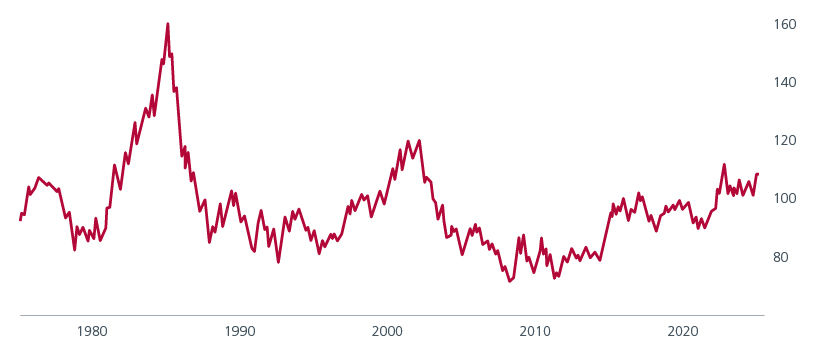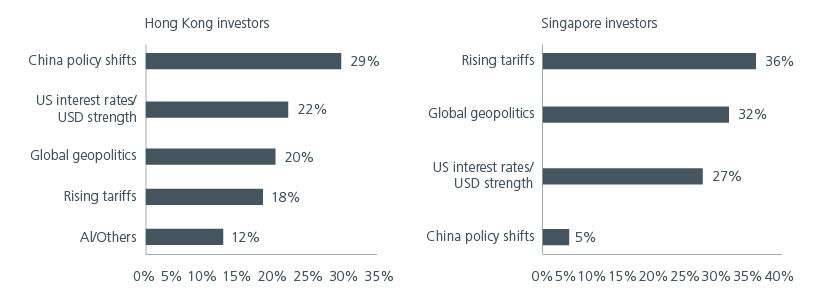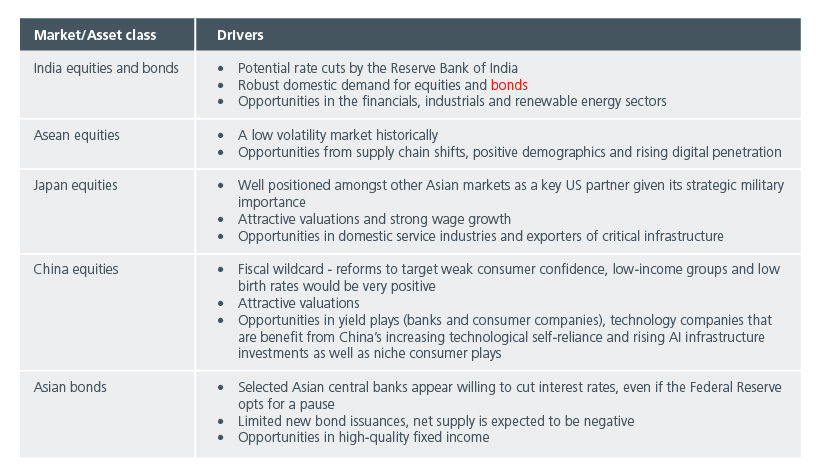Executive Summary
- The rising risks to the US growth narrative from Trump’s tariffs and immigration policy potentially warrant a rethink of the earlier playbook favouring US assets.
- The recent wobble in US AI stocks, triggered by Chinese AI lab Deepseek, also highlights the risks of crowded trades and concentrated positions.
- With their relatively low valuations, Asia and Emerging Markets have the potential to exceed expectations and provide genuine diversification benefits for investors, although active investing would be key to harnessing the alpha opportunities.
Investors entered the Trump 2.0 era positioned for more tariffs (especially targeted at China), higher inflation and a stronger US dollar (USD). Against this backdrop, investors had viewed US equities and the USD more favourably than Asian and Emerging Markets (EM) assets.
Although Trump has since imposed 10% tariffs on imports from China, the rising risks to the US growth narrative potentially warrant a rethink of the earlier playbook. The recent wobble in US AI stocks, triggered by Chinese AI lab Deepseek, also highlights the risks of crowded trades and concentrated positions. Analysis by our quantitative equity strategies team showed that despite the overall decline in the S&P 500 and sharp falls experienced by AI-related stocks on 27 January, about 70% of the S&P 500 constituents ended the day higher, demonstrating the importance of diversification in portfolios.
Rising risks to US exceptionalism
The US has enjoyed a period of tremendous growth and although the US economy is likely to remain the strongest within the G10 in 2025, risks to the highly consensus view of “US exceptionalism” is rising. Much of the US’ strong growth has been driven by productivity gains, of which imported labour played an important role. As such, the Trump administration’s plans to restrict immigration could constrain US growth over the medium term. Tariffs will also be an additional burden on the US consumer if they ignite inflationary pressures. If President Trump’s 25% tariffs on Mexico and Canada with a 10% rate for energy imports are followed through, these tariffs along with the 10% tariff on China could reduce US growth by 0.3% to 0.8% and increase US inflation by 0.4% to 0.8% on an annual basis.
Following Trump’s re-election, expectations of US tax cuts and deregulation, which are seen as stimulatory for US growth and inflation, had driven US assets and the dollar higher. The dollar index is near record highs not seen since 1985 and 2002. See Fig. 1. Although the Federal Reserve (Fed) kept interest rates on hold in January, further rate cuts cannot be ruled out in 2025 if the US unemployment rate rises. This could weaken the dollar, albeit not too drastically, as other central banks are also expected to cut rates. A peak in the dollar has historically been favourable for Asian and EM assets.
Fig. 1. Dollar Index

Source: Tradingeconomics.com. January 2025.
Embracing volatility
Besides tariffs, geopolitics, USD strength and China policy shifts are among the many other factors that could drive the markets this year. See Fig. 2.
Fig. 2. What do you think will be the key market driver in 2025?

Source: Eastspring Investments. Poll was taken at Eastspring Investments’ 2025 Market Outlook events in Singapore and Hong Kong in January which were attended by more than 100 institutional investors.
Given that markets are likely to stay volatile, there are several key considerations for investors. Firstly, US equities and the US dollar are expensive; historically, buying undervalued assets has proven more beneficial in the long run. Secondly, while the dominance of momentum trading over the past three years has reduced diversification in common indices, our multi-asset team stresses the importance of diversification and risk management even more during periods of high policy uncertainty. Equities that pay dividends and exhibit low volatility can help to reduce overall portfolio risk. Meanwhile, the relatively low valuations of EM equities present a stark contrast to the high prices of US equities. As Asia and EMs have the potential to exceed expectations, they can provide genuine diversification benefits for investors.
Active investing will be even more critical for investors in 2025. With tariff uncertainty looming at the regional/country level, the environment would be challenging for index returns and passive investing.
Diversified set of active opportunities
Despite the potential challenges at the country and regional levels in Asia and the EMs, our investment teams are leveraging on the following idiosyncratic drivers to uncover alpha opportunities at the security level:
Fig. 3. Idiosyncratic drivers and opportunities

Source: Eastspring Investments. January 2025.
The path forward for Asia and EMs will depend on the interplay between Fed policy, regional dynamics, and evolving investor sentiment. Incoming data on US unemployment will play a pivotal role in shaping the Fed's decisions. While the Federal Open Market Committee’s (FOMC) January statement and Chair Powell’s press conference included significant changes that the market perceived as slightly hawkish, leading to reduced expectations for rate cuts this year, we interpret Chair Powell's stance as still leaning towards a dovish outlook. The Fed is closely monitoring data to decide its next move, particularly showing sensitivity to any potential weaknesses in the labour market. This suggests that even if a rate cut in March is unlikely, a cut in May remains a possibility. Asia and EMs are well positioned to benefit from a shift to US lower rates and a weaker USD.
This commentary leverages on some of the key insights that were shared during Eastspring’s 2025 Market Outlook events held in Singapore and Hong Kong in January.
Access expert analysis to help you stay ahead of markets.
Singapore by Eastspring Investments (Singapore) Limited (UEN: 199407631H)
Australia (for wholesale clients only) by Eastspring Investments (Singapore) Limited (UEN: 199407631H), which is incorporated in Singapore, is exempt from the requirement to hold an Australian financial services licence and is licensed and regulated by the Monetary Authority of Singapore under Singapore laws which differ from Australian laws
Hong Kong by Eastspring Investments (Hong Kong) Limited and has not been reviewed by the Securities and Futures Commission of Hong Kong.
Indonesia by PT Eastspring Investments Indonesia, an investment manager that is licensed, registered and supervised by the Indonesia Financial Services Authority (OJK).
Malaysia by Eastspring Investments Berhad (200001028634/ 531241-U) and Eastspring Al-Wara’ Investments Berhad (200901017585 / 860682-K).
Thailand by Eastspring Asset Management (Thailand) Co., Ltd.
United States of America (for institutional clients only) by Eastspring Investments (Singapore) Limited (UEN: 199407631H), which is incorporated in Singapore and is registered with the U.S Securities and Exchange Commission as a registered investment adviser.
European Economic Area (for professional clients only) and Switzerland (for qualified investors only) by Eastspring Investments (Luxembourg) S.A., 26, Boulevard Royal, 2449 Luxembourg, Grand-Duchy of Luxembourg, registered with the Registre de Commerce et des Sociétés (Luxembourg), Register No B 173737.
Chile (for institutional clients only) by Eastspring Investments (Singapore) Limited (UEN: 199407631H), which is incorporated in Singapore and is licensed and regulated by the Monetary Authority of Singapore under Singapore laws which differ from Chilean laws.
The afore-mentioned entities are hereinafter collectively referred to as Eastspring Investments.
The views and opinions contained herein are those of the author, and may not necessarily represent views expressed or reflected in other Eastspring Investments’ communications. This document is solely for information purposes and does not have any regard to the specific investment objective, financial situation and/or particular needs of any specific persons who may receive this document. This document is not intended as an offer, a solicitation of offer or a recommendation, to deal in shares of securities or any financial instruments. It may not be published, circulated, reproduced or distributed without the prior written consent of Eastspring Investments. Reliance upon information in this document is at the sole discretion of the reader. Please carefully study the related information and/or consult your own professional adviser before investing.
Investment involves risks. Past performance of and the predictions, projections, or forecasts on the economy, securities markets or the economic trends of the markets are not necessarily indicative of the future or likely performance of Eastspring Investments or any of the funds managed by Eastspring Investments.
Information herein is believed to be reliable at time of publication. Data from third party sources may have been used in the preparation of this material and Eastspring Investments has not independently verified, validated or audited such data. Where lawfully permitted, Eastspring Investments does not warrant its completeness or accuracy and is not responsible for error of facts or opinion nor shall be liable for damages arising out of any person’s reliance upon this information. Any opinion or estimate contained in this document may subject to change without notice.
Eastspring Investments companies (excluding joint venture companies) are ultimately wholly owned/indirect subsidiaries of Prudential plc of the United Kingdom. Eastspring Investments companies (including joint venture companies) and Prudential plc are not affiliated in any manner with Prudential Financial, Inc., a company whose principal place of business is in the United States of America or with the Prudential Assurance Company Limited, a subsidiary of M&G plc (a company incorporated in the United Kingdom).















